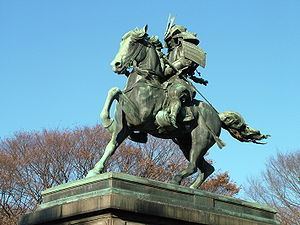Period 1331 – 1333 | ||
 | ||
Similar | ||
Genk war
The Genkō War (元弘の乱, Genkō no Ran) (1331–1333) also known as the Genkō Incident (元弘の変, Genkō no Hen) was a civil war in Japan which marked the fall of the Kamakura shogunate and end of the power of the Hōjō clan. The war thus preceded the Nanboku-chō period and the rise of the Ashikaga shogunate. Genkō is the name of the Japanese era corresponding to the period 1331-1334.
Contents
Throughout much of the Kamakura period, the shogunate was controlled by the Hōjō clan, whose members held the title of shikken (regent for the shogun), and passed it on within the clan. The Emperor was little more than a figurehead, holding no real administrative power.
In 1331, Emperor Go-Daigo plotted to seize power and overthrow the shogunate in Kamakura. However, he was betrayed by a trusted adviser Fujiwara Sadafusa. The Emperor fled Kyoto with the Sacred Treasures and sought refuge in a secluded monastery overlooking the Kizu River, called Kasagi. The monastery was attacked by Bakufu troops in the Siege of Kasagi. The emperor managed to escape, but only temporarily, and was subsequently banished to the Oki Islands. The shogunate then enthroned Emperor Kōgon.
The Emperor's son Prince Morinaga continued to fight, leading his father's supporters alongside Kusunoki Masashige.
Emperor Go-Daigo escaped Oki in the spring of 1333, two years after his exile, with the help of Nawa Nagatoshi (名和長年) and his family, raising an army at Funagami Mountain in Hōki Province (the modern town of Kotoura in Tōhaku District, Tottori Prefecture).
Meanwhile, Ashikaga Takauji, the chief general of the Hōjō family, turned against the Hōjō and fought for the Emperor in the hopes of being named shogun. Takauji entered Kyoto on 19 June and Go-Daigo entered the Palace at the end of July 1333. Simultaneously, Nitta Yoshisada led his army on a campaign through Kōzuke and Musashi provinces culminating in the siege of Kamakura, setting fire to the city, and destroying the Kamakura shogunate.
The city aflame, the shogunate fell, and the power of the Hōjō with it. Emperor Go-Daigo returned to Kyoto, and claimed power in what came to be known as the Kemmu Restoration. This would only last a few years, though. In 1336 Ashikaga Takauji named himself Shogun and seized power from Go-Daigo, beginning the Nanboku-chō Wars and the Ashikaga shogunate.
